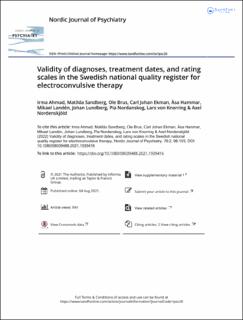| dc.contributor.author | Ahmad, Irma | |
| dc.contributor.author | Sandberg, Matilda | |
| dc.contributor.author | Brus, Ole | |
| dc.contributor.author | Ekman, Carl Johan | |
| dc.contributor.author | Hammar, Åsa Karin | |
| dc.contributor.author | Landén, Mikael | |
| dc.contributor.author | Lundberg, Johan | |
| dc.contributor.author | Nordanskog, Pia | |
| dc.contributor.author | von Knorring, Lars | |
| dc.contributor.author | Nordenskjöld, Axel | |
| dc.date.accessioned | 2023-03-08T12:47:44Z | |
| dc.date.available | 2023-03-08T12:47:44Z | |
| dc.date.created | 2022-05-18T09:34:16Z | |
| dc.date.issued | 2022 | |
| dc.identifier.issn | 0803-9488 | |
| dc.identifier.uri | https://hdl.handle.net/11250/3057080 | |
| dc.description.abstract | Background
The Swedish national quality register for electroconvulsive therapy (Q-ECT) contains data on patients receiving treatment with electroconvulsive therapy (ECT) in Sweden.
Aim
This study determined the validity of diagnoses, treatment dates, and rating scales in the Q-ECT by investigating the degree of accordance between data from the Q-ECT and patient records.
Materials and methods
From January 2016 to December 2017, 200 treatment series were randomly selected from the Q-ECT. The corresponding patient records were requested from the treating hospitals. Data on the indicative diagnosis, dates for the first and the last ECT session, and rating scales were compared between the Q-ECT and patient records using (i) a strict and (ii) a liberal method of assessment. Using the liberal method, each variable was assessed as accordant if it belonged to the same diagnosis group, or if the dates differed by less than 1 week, or ratings differed by only 1 point on the Clinical Global Impression Scale (CGI- S), or no more than 3 points on the Montgomery Åsberg Depression Rating Scale between the Q-ECT and the patient record.
Results
A total of 179 patient records were received. The strict method of assessment showed an accordance of 89% or higher for all studied variables. The liberal method showed an accordance of 95% or higher.
Conclusions
We conclude that data on the studied variables in the Q-ECT have high validity. However, limited use of some rating scales makes the results uncertain. Measures can be taken to further improve the data quality. | en_US |
| dc.language.iso | eng | en_US |
| dc.publisher | Taylor & Francis | en_US |
| dc.rights | Attribution-NonCommercial-NoDerivatives 4.0 Internasjonal | * |
| dc.rights.uri | http://creativecommons.org/licenses/by-nc-nd/4.0/deed.no | * |
| dc.title | Validity of diagnoses, treatment dates, and rating scales in the Swedish national quality register for electroconvulsive therapy | en_US |
| dc.type | Journal article | en_US |
| dc.type | Peer reviewed | en_US |
| dc.description.version | publishedVersion | en_US |
| dc.rights.holder | Copyright 2021 The Author(s) | en_US |
| cristin.ispublished | true | |
| cristin.fulltext | original | |
| cristin.qualitycode | 1 | |
| dc.identifier.doi | 10.1080/08039488.2021.1939416 | |
| dc.identifier.cristin | 2025048 | |
| dc.source.journal | Nordic Journal of Psychiatry | en_US |
| dc.source.pagenumber | 96-103 | en_US |
| dc.identifier.citation | Nordic Journal of Psychiatry. 2022, 76 (2), 96-103. | en_US |
| dc.source.volume | 76 | en_US |
| dc.source.issue | 2 | en_US |

